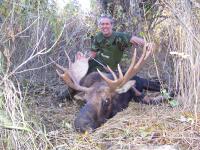Moose Hunting Tips
The Animal:

moose with droptine
There are 3 species of moose roaming about. The largest are the Yukon moose, you can find them in there name. The next largest moose are the Canadian moose which are just south of the Yukon and can be found from east to west in Canada. The Shiras moose can be found in the southern parts of Canada and northern parts of the States. A big Yukon moose can weigh in at the 1800lbs mark. Moose can be very tasty so be sure to try some Moose meat recipes once you bag one of these great bulls. The main predators for moose are wolves.
Before you go on your moose hunting trip, be sure to do your scouting homework and know what type of hunting equipment, like boots to bring.

Mature bull moose in Northern BC
The Season:
Moose hunting begins during August in Canada, but the rut usually begins close to the end of September/ beginning of October where I hunt. The farther north you are the earlier they rut.
Pre-rut, your best chances is to cover ground looking at meadows, swamps, sub-alpine areas, cut lines, and slashes coupled with calling to find moose.

moose meadow
During the rut, cow calling will be the most successful strategy. Remember to hang out around the swamps and wallows. Some people like bull grunting but most guides prefer cow calling and it seems like that is your best strategy to bag a bull moose.
Moose hunting ends at the end of October were I hunt. Then the moose are finished the rut. It is definitely easier to hunt moose during the rut as they are responsive to calling.
Strategies:
I touched on this already but cow calling is your main tool on a moose hunt. Don’t go out and buy moose calls unless it is the birch bark cone. I found most commercial moose calls sounding worse then clasping your hands to make the call. You can roll up a piece of birch bark in a cone shape to use as a call. A milk jug with a hole and a rope going through it can make a good call, just add water. I’ve even seen an old timer out there with a pylon, and that made a good call.
To make the thrashing sound of a bull you can beat the willow bushes with a big stick or a paddle. Some moose hunters even use the paddles as antlers to fool a big moose. Sometimes bull grunting and willow thrashing is the best ticket to get the bulls in close for that archery shot.
Scent Management:
Moose have huge noses and ears, so I can only surmise that they hear and smell very well. I use “mare in heat” urine to douse my hat and boots. You can even dampen a rag and carry it in your pocket. You can set up a doused cloth 50 yards from your blind/stand.
Field Judging:
Generally the farther north you go the bigger the moose will be so don’t be holding out for an Alaskan sized rack if you are hunting in Montana. Secondly all moose look huge so forget judging body size to find a trophy. You want to look for a couple main antler characteristics to see if your bull moose is mature. If it has the tri-palm bottoms (3points on the bottom paddles on each side), it most likely is mature. If it has big, wide, and tall paddles on top it is a mature bull. If it has short skinny top paddles or no paddles, it is a dink. Immature bulls are referred to as spike bulls as they have not yet developed paddles.

